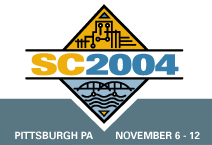TCBG Software at SC2004

|
SC2004 Talks and Demonstrations
|
NIH National Center for Research Resources Booth Presentations
The Theoretical and Computational Biophysics Group (TCBG), an NIH Resource for Macromolecular Modeling and Bioinformatics, is located at the Beckman Institute of the University of Illinois at Urbana-Champaign (UIUC). The Resource brings advanced molecular modeling, bioinformatics, and computational technologies to bear on questions of biomedical relevance through direct collaboration with experimental researchers, the distribution of user-friendly cutting-edge software, and a broad range of training and dissemination activities.
 The flagship TCBG software packages NAMD, VMD, and BioCoRE, all
distributed free of charge with source code, facilitate the discovery
process from analysis, through modeling, to visualization of the molecular
apparatus in biological cells:
The flagship TCBG software packages NAMD, VMD, and BioCoRE, all
distributed free of charge with source code, facilitate the discovery
process from analysis, through modeling, to visualization of the molecular
apparatus in biological cells:
- NAMD, recipient of a 2002 Gordon Bell Award, is a parallel molecular dynamics code used regularly to simulate systems of 300,000 atoms and beyond on both large supercomputers and inexpensive Linux clusters.
- VMD is a molecular visualization program for displaying, animating, and analyzing large biomolecular systems using hardware-accelerated 3-D graphics and built-in scripting.
- BioCoRE is a collaborative work environment that allows biomedical researchers to visualize information, to share resources, and to interact with each other and with research tools via a common infrastructure and across distance.
NCSA Booth Presentation
Computational and experimental biologists investigate jointly the physical mechanisms underlying the function of the molecular machines in cells. Using the Linux clusters at NCSA and the program NAMD, researchers at the Theoretical and Computational Biophysics Group at the University of Illinois can regularly simulate systems of 300,000 atoms and beyond, visualizing and analyzing the results with the program VMD. The BioCoRE software enables communication among collaborators and simplifies access to supercomputing resources. The simulations of the MscS mechanosensitive membrane channel highlighted in this presentation will demonstrate how this NIH-supported, freely available (at www.ks.uiuc.edu) software and NSF supercomputing centers are opening a new era in computational biology.



